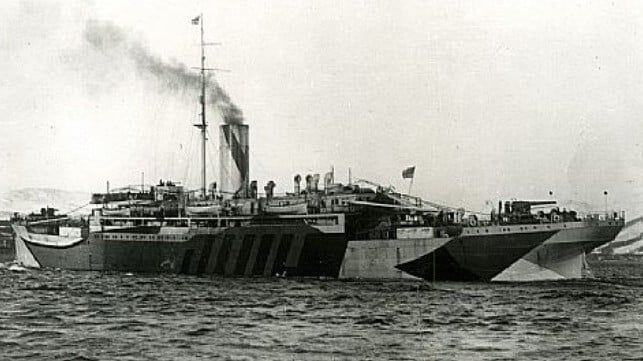Divers Identify Wreck of WWI Merchant Cruiser HMS Bayano

Amateur divers have identified the wreck of the British armed merchant cruiser HMS Bayano, which was torpedoed and sunk off Scotland by a German sub in World War I.
HMS Bayano was a merchant steamer pressed into service as a warship, one of dozens of armed merchant cruisers (AMCs) that the Royal Navy refitted in order to fill a shortage of midsize surface combatants. These improvised gunships conducted enforcement of the allied naval blockade on Germany, served as escorts, and conducted patrol duties near British shores. 17 were lost over the course of the war.
The vessel began life as the banana boat SS Bayano, a reefer ship delivered in 1913. The vessel was requisitioned for naval service in November 1914 and swiftly refitted at Avonmouth, receiving two six-inch guns - one forward and one aft. While the steamer was a fine vessel, Bayano's squadron commander commented shortly after redelivery that the banana boats were vulnerable in a fight. "The two large holds have no sub division, being only two large tanks, and the flooding of either would be sufficient to sink the ship," the admiral warned.
Bayano's entry into service coincided with the German government's decision to begin unrestricted submarine warfare, and she would be the first British victim of that campaign. At 0515 in the morning on March 11, 1915, the U-boat U-27 fired a single torpedo at HMS Bayano as the vessel was transiting the North Channel. The ship was hit just forward of the bridge and sank within minutes, too fast to launch the lifeboats or to get sleeping crewmembers out from belowdecks. Survivors reported that the wireless operator and the captain remained behind as the vessel sank, without attempting to abandon ship.
Those who donned life belts and made it over the side had to contend with icy water; would-be rescuers were put off by the presence of U-27, which had surfaced to look for other targets. Ultimately only 27 men survived and were rescued out of a total ship's complement of about 220 people.
"If the vessel had not gone down so quickly, I believe all aboard would have been saved," ship's telegraphist John Taylor told media after his rescue.
The remains of the Bayano sat amongst multiple large wrecks in the outer Firth of Clyde and North Channel, making identification a challenge. The water depth in the area is about 100-200 meters, too deep for standard recreational dive techniques, and the wreck had not been identified previously. The dive team - operating under the name of ProjectXplore - started their work to find Bayano with research at the UK's national archives. Once they had figured out a search box for the approximate area where the ship went down, they began a sidescan sonar survey using a small commercial dive boat.
They found the wreck's sonar signature at a position southwest of the island of Ailsa Craig, at the edge of the Firth of Clyde. A technical dive confirmed the vessel's identity quickly: Bayano was the only missing merchant cruiser with two six-inch guns, one forward and one aft, and the wreck had both. Other factors reinforced this conclusion, including her general arrangements, the refrigeration plant, the shape of her transom and the style of her railings.
"From a naval historical perspective, the sinking of HMS Bayano heralded a new era: she was arguably the first major British casualty of Germany’s policy of unrestricted submarine warfare, declared on 2 February 1915, just over one month before her sinking," wrote the dive team in an after-action report. "From a social history perspective, the sinking of HMS Bayano revealed both the efficacy and moral dilemma of the doctrine of targeting mixed-use vessels under wartime conditions – and the significant loss of life and outpouring of grief in coastal communities around the North Channel demonstrated how the tragedy touched communities far beyond those directly connected to the ship and her crew."
